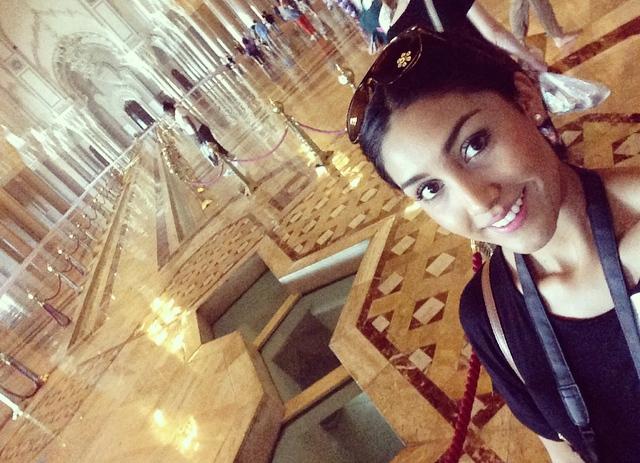Kimberly Valle visits the Mosquee Hassan II
Uncovering the largest city in Morocco
March 3, 2016
My classmates and I were booked into a hotel near the beach in Casablanca. We made our way down toward the reception dinner, where we found several different foods along with dessert displayed on a buffet table. We were kindly greeted by a Moroccan waitress who escorted us to our tables. We had time to get to know each other more and talk about our homes in America, and despite our jet lag we decided to go out and explore Casablanca.
I was surprised at how many women were not wearing the hijab and were showing their arms and legs. I came to realize that Morocco is very westernized; the people all have a sense of style by wearing the latest fashion labels and trends.
The next morning we got up extra early to make our way to visit the Hassan II Mosque, this mosque is the largest in North Africa and the seventh largest in the world. It was completed in 1993, and almost took a decade to complete. A French man by the name of Michel Pinseau designed it. The tower of the mosque is 60 stories high, and is topped by a laser. The light from the laser is directed toward Mecca. The mosque is built on top of the Atlantic Ocean, where the sea is visible through the glass floor of the building’s hall. Nearly 105,000 worshipers gather weekly inside to pray.
We had our own personal tour guide, who was educating us about the material the mosque is made out of and the history behind it. I was in such amazement about how enormous the mosque is and, most importantly, I was astonished about the details of the architecture and the view it had of the Atlantic Ocean. We made our way downstairs, where worshipers clean themselves before prayer, and that area itself was also built is such delicate manner.
After that tour of Hassan II Mosque, I gained so much respect for their religion, not that I did not have any before, but learning the procedures it takes to pray, and that they do this five times a day. I thought mosques and homes were the only place Muslims could pray until I kept witnessing many men along the streets, who prayed in public once the call to prayer began. It took me a little while to get used to both seeing men pray in the streets and hearing the peaceful call to prayer–five times perday.
Casablanca is the largest city in Morocco and it is one of the major tourist cities of the country and the most important in Africa. There are a handful of international corporate businesses in the city, which makes Casablanca one of the main industrialized zones. The Port of Casablanca is one of the largest artificial ports in the world and it’s the primary naval base for the Royal Moroccan Navy.
Casablanca’s history reaches far back to the seventh century BC, which was settled by Berbers, and was later controlled by Portuguese in the 15th century, changing its name to what is it now. In the 18th century, an earthquake destroyed most of the town. The sultan who changed the name into the local Arabic, A-ddar Al Baidaa, had rebuilt it, however during the French colonization in Morocco, Casablanca remains its permanent name.
My classmates and I hopped on a white tourist bus and cruised around the city, I couldn’t help but notice all the French-influenced architecture in Casablanca. Some streets look European and others have the Moroccan feel to them, with their large round doors that each have their own details and their marble-engraved walls. I also noticed the exciting patriotism Morocco has for its country, with the many flags displayed all over the city, practically in every tall building.
We arrived at another building, where we got off the bus. There was a nearby plaza full of Moroccan flags and street birds. There were people taking pictures with the birds on top of them. I didn’t have the courage to have birds all over me, as I was afraid of them having an accident on me.
After we fed the birds, we made our way to Old Casablanca, where we explored the medina, which is the local shops where clothing, food and other objects are sold, I was surprised at the amount of buckets of olives their local markets had and the different kinds there was, I then realized olives are a thing in Morocco.
I kept getting lost in the wonderful architecture and materials that were in the local shops; I couldn’t wait to start shopping for my family and friends.
